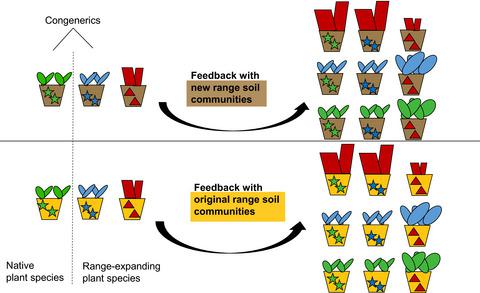Our official English website, www.x-mol.net, welcomes your feedback! (Note: you will need to create a separate account there.)
Community‐level interactions between plants and soil biota during range expansion
Journal of Ecology ( IF 5.5 ) Pub Date : 2020-04-23 , DOI: 10.1111/1365-2745.13409 Kadri Koorem 1, 2 , Basten L. Snoek 1, 3, 4 , Janneke Bloem 1, 5 , Stefan Geisen 1, 4 , Olga Kostenko 1 , Marta Manrubia 1 , Kelly S. Ramirez 1 , Carolin Weser 1 , Rutger A. Wilschut 1, 6 , Wim H. Putten 1, 4
中文翻译:

范围扩大过程中植物与土壤生物区系之间的社区级互动
更新日期:2020-04-23
Journal of Ecology ( IF 5.5 ) Pub Date : 2020-04-23 , DOI: 10.1111/1365-2745.13409 Kadri Koorem 1, 2 , Basten L. Snoek 1, 3, 4 , Janneke Bloem 1, 5 , Stefan Geisen 1, 4 , Olga Kostenko 1 , Marta Manrubia 1 , Kelly S. Ramirez 1 , Carolin Weser 1 , Rutger A. Wilschut 1, 6 , Wim H. Putten 1, 4
Affiliation

|
- Plant species that expand their range in response to current climate change will encounter soil communities that may hinder, allow or even facilitate plant performance. It has been shown repeatedly for plant species originating from other continents that these plants are less hampered by soil communities from the new than from the original range. However, information about the interactions between intra‐continental range expanders and soil communities is sparse, especially at community level.
- Here we used a plant–soil feedback experiment approach to examine if the interactions between range expanders and soil communities change during range expansion. We grew communities of range‐expanding and native plant species with soil communities originating from the original and new range of range expanders. In these conditioned soils, we determined the composition of fungi and bacteria by high‐throughput amplicon sequencing of the ITS region and the 16S rRNA gene respectively. Nematode community composition was determined by microscopy‐based morphological identification. Then we tested how these soil communities influence the growth of subsequent communities of range expanders and natives.
- We found that after the conditioning phase soil bacterial, fungal and nematode communities differed by origin and by conditioning plant communities. Despite differences in bacterial, fungal and nematode communities between original and new range, soil origin did not influence the biomass production of plant communities. Both native and range expanding plant communities produced most above‐ground biomass in soils that were conditioned by plant communities distantly related to them.
- Synthesis. Communities of range‐expanding plant species shape specific soil communities in both original and new range soil. Plant–soil interactions of range expanders in communities can be similar to the ones of their closely related native plant species.
中文翻译:

范围扩大过程中植物与土壤生物区系之间的社区级互动
- 应对当前气候变化而扩大范围的植物物种将遇到可能阻碍,允许甚至促进植物生长的土壤群落。对于来自其他大陆的植物物种已经反复表明,这些植物比新物种受到的土壤群落的阻碍要小。但是,关于洲际范围扩展器与土壤群落之间相互作用的信息很少,尤其是在群落一级。
- 在这里,我们使用植物-土壤反馈实验方法来检查范围扩展期间范围扩展器与土壤群落之间的相互作用是否发生了变化。我们培育了范围扩大和本地植物物种的社区,而土壤社区则来自范围扩大器的原始和新范围。在这些条件化土壤中,我们分别通过ITS区和16S rRNA基因的高通量扩增子测序来确定真菌和细菌的组成。线虫群落组成是通过基于显微镜的形态学鉴定确定的。然后,我们测试了这些土壤群落如何影响范围扩展者和当地居民的后续群落的生长。
- 我们发现,在适应阶段之后,土壤细菌,真菌和线虫群落在起源和适应植物群落方面都不同。尽管原始范围和新范围之间细菌,真菌和线虫的群落存在差异,但土壤来源并未影响植物群落的生物量生产。原生植物和范围扩大的植物群落都在土壤中产生大部分地上生物量,而土壤生物量是由与其密切相关的植物群落所调节的。
- 综合。范围扩大的植物物种群落在原始和新的土壤中均形成特定的土壤群落。群落中增程剂的植物-土壤相互作用可能与其亲缘关系密切的本地植物物种相似。



























 京公网安备 11010802027423号
京公网安备 11010802027423号